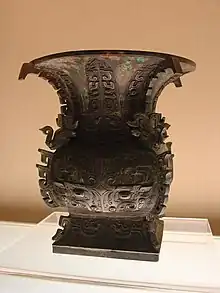尊
| ||||||||
Translingual
Han character
尊 (Kangxi radical 41, 寸+9, 12 strokes, cangjie input 廿田木戈 (TWDI), four-corner 80346, composition ⿱酋寸)
References
- KangXi: page 295, character 10
- Dai Kanwa Jiten: character 7445
- Dae Jaweon: page 585, character 1
- Hanyu Da Zidian (first edition): volume 1, page 509, character 6
- Unihan data for U+5C0A
Chinese
| trad. | 尊 | |
|---|---|---|
| simp. # | 尊 | |
| 2nd round simp. | 𰃝 | |
| alternative forms | 𡭆 𢍜 𥈪 | |

Glyph origin
| Historical forms of the character 尊 | |||
|---|---|---|---|
| Shang | Western Zhou | Shuowen Jiezi (compiled in Han) | Liushutong (compiled in Ming) |
| Oracle bone script | Bronze inscriptions | Small seal script | Transcribed ancient scripts |
 |
 |
 |
 |
Ideogrammic compound (會意) : 酋 (“vinegar”) + 寸 (“hand”) – to give 寸 (cùn) an offering 酋 (qiú) – to show respect, veneration.
Etymology
Cognate to Tibetan བཙུན (btsun), བཙུན་པ (btsun pa, “respectable, venerable”), མཚུན (mtshun, “ancestor god”). The "vessel" sense is because it was used in ritual ceremonies (Schuessler, 2007).
Pronunciation
Definitions
尊
Compounds
|
|
|
Related terms
- 樽 (zūn)
Japanese
| Shinjitai | 尊 | |
| Kyūjitai [1] |
尊󠄂 尊+ 󠄂?(Adobe-Japan1) |
 |
| 尊󠄄 尊+ 󠄄?(Hanyo-Denshi) (Moji_Joho) | ||
| The displayed kanji may be different from the image due to your environment. See here for details. | ||
Kanji
Readings
Compounds
- 尊翰 (sonkan)
- 尊顔 (songan)
- 尊敬 (sonkyō, “respect, honor”)
- 尊兄 (sonkei, “(honorific) older brother”)
- 尊敬 (sonkei, “respect”)
- 尊厳 (songen, “dignity”)
- 尊称 (sonshō, “honorific title”)
- 尊心 (sonshin)
- 尊崇 (sonsū), 尊崇 (sonsō, “reverence, veneration”)
- 尊属 (sonzoku, “direct ancestors”)
- 尊体 (sontai, “(honorific) one's health”)
- 尊大 (sondai, “haughty, arrogant”)
- 尊重 (sonchō, “respect”)
- 尊卑 (sonpi)
- 尊父 (sonpu)
- 尊慮 (sonryo)
- 三尊 (sanson)
- 三尊 (Sanzon)
- 至尊 (shison)
- 自尊 (jison)
- 自尊心 (jisonshin)
- 釈尊 (Shakuson)
- 世尊 (Seson)
- 追尊 (tsuison)
- 独尊 (dokuson)
- 天上天下唯我独尊 (tenjō tenge yuiga dokuson)
- 本尊 (honzon), 本尊 (hozon)
Etymology 1
| Kanji in this term |
|---|
| 尊 |
| みこと Grade: 6 |
| kun’yomi |
From Old Japanese.
Derived from 御 (mi-, honorific prefix) + 事 (koto, “thing, matter”).
Alternative forms
Noun
尊 • (mikoto)
- (Shinto) indicates respect and reverence, such as to the 神 (kami, “Shinto deity”) or the 天皇 (tennō, “Emperor of Japan”): Highness
- (by extension) indicates respect to a superior or other high-ranking person
- indicates deep affection: beloved
- 711–712, Kojiki (poem 4)
- ...和加久佐能都麻能美許登許登能加多理碁登母許遠婆 [Man'yōgana]
- ...若草の妻のみこと事の語り言もこをば [Modern spelling]
- wakakusa no tsuma no mikoto koto no katarigoto mo ko o ba
- (please add an English translation of this example)
- 711–712, Kojiki (poem 4)
Derived terms
- 天つ尊 (Amatsumikoto)
- 天忍穂耳尊 (Amenōshihomimi no Mikoto)
- 天常立尊 (Amanotokotachi no Mikoto)
- 天命開別尊 (Amemikoto Hirakasuwake no Mikoto)
- 伊弉諾尊 (Izanagi no Mikoto)
- 伊弉冉尊 (Izanami no Mikoto)
- 鸕鷀草葺不合尊 (Ugayafukiaezu no Mikoto)
- 小碓尊 (Ōsu no Mikoto)
- 置瀬尊 (Okise no Mikoto)
- 草分尊 (Kusawake no Mikoto)
- 国常立尊 (Kuninotokotachi no Mikoto), 国底立尊 (Kuninosokotachi no Mikoto)
- 素戔嗚尊 (Susanō no Mikoto)
- 天皇, 皇尊 (sumeramikoto)
- 高皇産霊尊 (Takamimusuhi no Mikoto)
- 月読尊, 月夜見尊 (Tsukiyomi no Mikoto)
- 豊斟渟尊 (Toyokumune no Mikoto)
- 瓊瓊杵尊 (Ninigi no Mikoto)
- 彦火火出見尊 (Hikohohodemi no Mikoto)
- 皇子尊 (miko no mikoto)
- 御孫尊 (mima no mikoto)
- 日本武尊 (Yamato Takeru no Mikoto)
Pronoun
尊 • (mikoto)
- (archaic, derogatory) second person personal pronoun: you
- (archaic) third person pronoun
Derived terms
- 我尊, 和尊 (wamikoto)
Etymology 2
| Kanji in this term |
|---|
| 尊 |
| とうと Grade: 6 |
| kun’yomi |
⟨taputo1⟩ → */taputʷo/ → /tafuto/ → /tauto/ → /tɔːto/ → /toːto/
From Old Japanese.
Stem of classical adjective 尊し (tafutoshi → tōtoshi), modern 尊い (tōtoi, “precious, sacred”).
Alternative forms
Noun
尊 • (tōto) ←たふと (tafuto)?
- respect, reverence
- 1702, Oku no Hosomichi
- あらたうと 青葉若葉の 日の光
- ara-tōto, aoba wakaba no, hi no hikari
- (please add an English translation of this example)
- あらたうと 青葉若葉の 日の光
- 1702, Oku no Hosomichi
Derived terms
- 尊がる (tōtogaru)
- 尊ぶ (tōtobu)
- 尊む (tōtomu)
Pronunciation
- Pronunciation for suffix sense unknown.
Etymology 4
| Kanji in this term |
|---|
| 尊 |
| Grade: 6 |
| irregular |
Nominalization of classical adjective 高し (takashi), modern 高い (takai, “high”).
Etymology 5
| Kanji in this term |
|---|
| 尊 |
| Grade: 6 |
| irregular |
Various theories exist, possibly a nominalization of verb 長ける (takeru, “to excel at”).
References
- “尊”, in 漢字ぺディア (Kanjipedia) (in Japanese), 日本漢字能力検定協会, 2015—2023
- 2006, 大辞林 (Daijirin), Third Edition (in Japanese), Tōkyō: Sanseidō, →ISBN
Korean
Vietnamese
Han character
尊: Hán Việt readings: tôn (
尊: Nôm readings: tôn[2][4], nhôn[3][5], ton[3][5], chun[1], tông[1], tun[5]
References
- Nguyễn (2014).
- Nguyễn et al. (2009).
- Trần (2004).
- Taberd & Pigneau de Béhaine (1838).
- Hồ (1976).